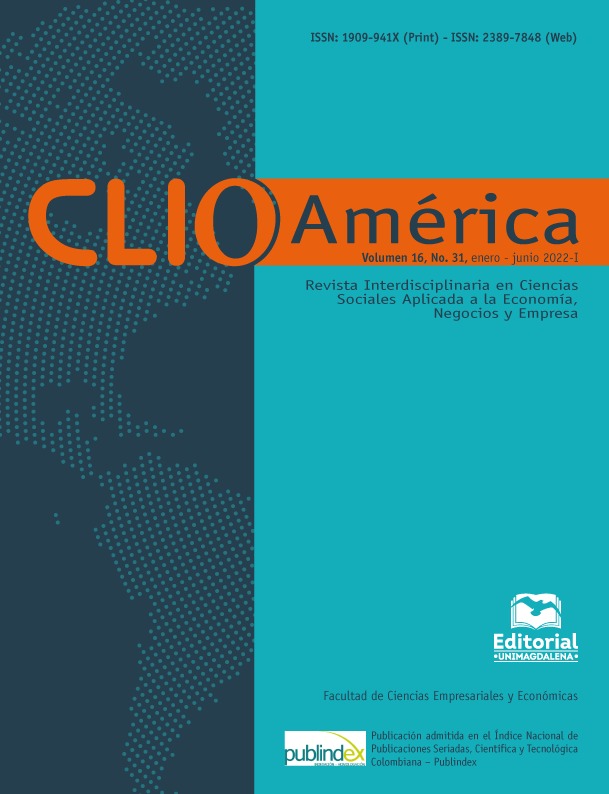Abstract
This paper seeks to determine what socioeconomic aspects influence the economic reintegration process of former combatants from illegal armed groups in Bolívar, Colombia. For this purpose, an analysis of some variables such as age, gender, educational level, marital status, former group, family income and type of demobilization is carried out. Methodologically, a two-stage econometric binary choice model (Probit) was applied. This research found that educational level, family income and gender are the key socioeconomic determinants of economic reintegration in the population under study. Finally, the scholar community is invited to carry out studies of this type in order to understand the factors that can affect the economic re- integration of ex-combatants across the country. These analyzes provide critical information for designing more successful reintegration programs for insurgent groups, considering that Colombia is currently going through a massive demobilization process which will require a successful reintegration program that pre- vent former combatants from recidivism.References
Allgood, S. (2020). Age Discrimination and Academic Labor Markets. Journal of Economic Behavior & Organization 169, 70-78. https://doi.org/10.1016/j.jebo.2019.10.024
Ariza, M., Acosta, K. & Altamar, L. (2016). Aplicación de los Modelos de Respuesta Binaria a los Determinantes de la Demanda de Postgrado en Colombia. Escenarios, 14(1), 7-18. http://dx.doi.org/10.15665/esc.v14i1.874
Baquero, J., Guataqui, J. & Sarmiento, L. (2000). Un Marco Analítico de la Discriminación Laboral. Borradores de investigación, 8(1), 2-31. https://repository.urosario.edu.co/handle/10336/10807
Becker, G. (1993). Human Capital: A Theoretical and Empirical Analysis, with Special Reference to Education. The National Bureau of Economic Research. https://www.nber.org/books-and-chapters/human-capital-theoretical-and-empirical-analysis-special-reference-education-third-edition
Bordignon, N. (2005). El Desarrollo Psicosocial de Eric Erikson. El diagrama epigenético del adulto. Revista Lasallista de Investigación, 2(2), 50-63. https://www.redalyc.org/pdf/695/69520210.pdf
Borjas, G. (2000). Economics of Migration. International Encyclopedia of the Social and Behavioral Sciences, 3(38), 1-21. https://citeseerx.ist.psu.edu/viewdoc/download?doi=10.1.1.453.6650&rep=rep1&type=pdf
Braña, F. & Antón, J. (2007). Determinantes de la Inserción Laboral de los Jóvenes en España. Revisión y Nueva Evidencia Empírica. Anuales de economía aplicada, 10(1), 44-67. https://dialnet.unirioja.es/servlet/articulo?codigo=5181268
Braun, C., Nusbaum, C. & Rupert, P. (2020). Labor Market Dynamics and the Migration Behavior of Married Couples. Review of economics dynamics, Elsevier for the Society for Economic. http://dx.doi.org/10.1016/j.red.2020.11.001
Carlsson, M. & Eriksson, S. (2019). Age Discrimination in Hiring Decisions: Evidence from a Field Experiment in the Labor Market. Labour Economics, 59, 173-183. http://dx.doi.org/10.1016/j.labeco.2019.03.002
Choi, J., Choi, J. & Son, H. (2020). The Long-term Effects of Labor Market Entry in a Recession: Evidence from the Asian Financial Crisis. Labour Economics, 67, 101926. http://dx.doi.org/10.1016/j.labeco.2020.101926
De Coning, C. & Romita P. (2009). Monitoring and Evaluations of Peace Operation. International Peace Institute. https://www.ipinst.org/wpcontent/uploads/publications/ipi_rpt_m_and_e_of_peace_ops_epub.pdf
Department of National Planning - DNP. (2015). CONPES 3850: Fondo Colombia en Paz. Department of National Planning. https://colaboracion.dnp.gov.co/CDT/Conpes/Econ%C3%B3micos/3850.pdf
Department of National Planning - DNP. (2018). CONPES 3931: Política Nacional para la Reincorporación Social y Económica de Exintegrantes de las FARC-EP. Department of National Planning. https://www.reincorporacion.gov.co/es/Documents/conpes_finlal_web.pdf
Escobar, Á., Luna, J. & López, N. (2019). Reintegración Económica: Conceptualización y Estrategias Implementadas en Colombia y Otros Países. Saber, Ciencia y Libertad, 14(1): 118-139.https://doi.org/10.18041/2382-3240/saber.2019v14n1.5211
Geyers, J., Haan, P., Hammerschmid, A. & Peters, M. (2020). Labor Market and Distributional Effects of an Increase in the Retirement Age. Labour Economics, 65, 101817. http://dx.doi.org/10.1016/j.labeco.2020.101817
Giraldo, S. (2010). Contextualización teórica e histórica de la reintegración social y económica de desmovilizados en Colombia. Poliantea, 6(11), 35-52. https://journal.poligran.edu.co/index.php/poliantea/article/view/198
Giustozzi, A. (2016). Post-conflict Disarmament, Demobilization and Reintegration: Bringing State-building Back in. Taylor and Francis. http://dx.doi.org/10.4324/9781315601656
Groot, W., Hartog, J. & Oosterbeek, H. (1994). Cost and revenues of investment in Enterprise-Related schooling. Oxford Economics papers, 46(4), 658-75. https://www.jstor.org/stable/2663515#metadata_info_tab_contents
Gujarati, D. y Porter, D. (2009). Econometría. Quinta Edición. Mc Graw Hill. https://www.academia.edu/33064534/Gujarati_Econometr%C3%ADa_5ta_Edici%C3%B3n_pdf
Humphreys, M. & Weinstein, J. (2007). “Demobilization and Reintegration. Journal of Conflict Resolution, 51(4), 531-567. http://dx.doi.org/10.1177/0022002707302790
Kapplan, O. & Nussio, E. (2018). Explaining Recidivism of Ex-Combatants in Colombia. Journal of Conflict Resolution, 62(1): 64-93. http://dx.doi.org/10.1177/0022002716644326
Kerr, S., Pekkarinen, T., Sarvimäki, M. & Uusitalo. (2020). Post-Secondary Education and Information on Labor Market Prospects: A Randomized Field Experiment”. Labour Economics, 66, 101888. http://dx.doi.org/10.1016/j.labeco.2020.101888
Kokot, P. (2015). Let's Talk About Sex(ism): Cross-national Perspectives on Women Partners’ Narratives on Equality and Sexism at Work in Germany and the UK. Critical Perspectives on Accounting, 27, 73-85. http://dx.doi.org/10.1016/j.cpa.2014.02.002
Kriger, J. (1999). British Politics in the Global Age: Can Social Democracy Survive? Oxford University. https://books.google.com.co/books/about/British_Politics_in_the_Global_Age.html?id=BNbksZgI5a4C&redir_esc=y
López, H. (2001). Características y Determinantes de la Oferta Laboral Colombiana y su Relación con la Dinámica del Desempleo. Chapter in Urrutia, Miguel (Ed.), Empleo y Economía (pp. 156-192). Banco de la República. http://dx.doi.org/10.32468/Ebook.664-099-X
McQuaid, R. & Lindsay, C. (2005). The Concept of Employability. Urban Studies, 42(2), 197-219. https://doi.org/10.1080/0042098042000316100
Ministry of Education of Colombia (2010). Niveles de Educación Básica y Media.. https://www.mineducacion.gov.co/1759/w3-article-233834.html
Muggah, R. & O´Donnell, C. (2015). Next Generation Disarmament, Demobilization and Reintegration. Stability, 4(1). http://dx.doi.org/10.5334/sta.fs
Munive, J. & Stepputat, F. (2015). Rethinking Disarmament, Demobilization and Reintegration Programs. Stability, 4(1). http://dx.doi.org/10.5334/sta.fs
Muthén, B. (1979). A Structural Probit Model with Latent Variables. Journal of the American Statistical Association 74(368), 807-811. http://dx.doi.org/10.1080/01621459.1979.10481034
Oswald-Egg, M. & Renold, U. (2021). No Experience, No Employment: The Effect of Vocational Education and Training Work Experience on Labour Market Outcomes After Higher Education. Economics of Education Review, 80, 102065. http://dx.doi.org/10.1016/j.econedurev.2020.102065
Peng, C. & She, P. (2020). Are Women Less Likely to be Managers in the UK Labour Market? Economic Modeling, 85, 317-324. http://dx.doi.org/10.1016/j.econmod.2019.10.021
Rhyn, L. (2019). Overcoming Stigma and Fostering Participation: Mechanisms for Community Reintegration in Colombia. Conflict, Security and development, 19(2), 195-222. http://dx.doi.org/10.1080/14678802.2019.1586157
Ruzek, W. (2015). “The informal Economy as a Catalyst for Sustainability”. Sustainability, 7(1), 23-34. http://dx.doi.org/10.3390/su7010023
Song, M. (1995). Between “The Front” and “The Back”: Chinese Women's Work in Family Businesses. Women´s Studies International Forum, 18(3), 285-298. http://dx.doi.org/10.1016/0277-5395(95)80073-X
Thorsell, S. (2013). Towards People-centred Economic Reintegration? An Analysis of the Economic Reintegration Strategy of Demobilized Combatants in Colombia. Colombia Internacional, 77, 177-215. http://dx.doi.org/10.7440/colombiaint77.2013.07
United Nations - UN. (2011). Third Report of the Secretary –General on DDR. http://unddr.org/uploads/documents/IDDRS_4.30%2 0Reintegration%20WEB.pdf
United Nations - UN. (2019). Integrated Disarmament, Demobilization and Reintegration Standars (IDDRS). https://www.unddr.org/the-iddrs/level-1/

This work is licensed under a Creative Commons Attribution-NonCommercial-ShareAlike 4.0 International License.


